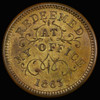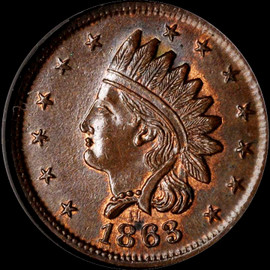PCGS MS64 1863 Oliver Boutwell NY Token F-890B-6b Brass PE - Bowers Collection
"The Tokens of the Boutwells of Troy, New York," The Numismatist, April 1952 notes: "Any collector of United States tokens, no matter what field he specializes in, at one time or another has come across the issues of the Boutwells of Troy, New York. Oliver Boutwell began business as a baker at 314 River Street, Troy, in 1831. In 1833 he moved to 7 Grand Division Street, and in 1836 he admitted his brother, Phardice, to partnership. The following year Oliver withdrew, and in 1837 established himself as a miller near 'Sloop Lock,' continuing alone until after the Civil War. The firm, known as O. Boutwell & Son, were millers and dealers in flour, wheat, rye, oats, and corn. A two-story mill was erected at the 'Sloop Lock' in 1837 by Oliver Boutwell when he first engaged in his business. One of the mills later erected by this firm burned on August 4, 1890, and was replaced by a four-story mill built of brick. In 1866, Charles A. Boutwell became associated with his father under the name of O. Boutwell and Son. Now, as to the token issued by this company, the first one issued was in 1835, during the Hard Times period, by O. & P. Boutwell, Bakers and Confectioners. Later, during the Civil War, another extensive issue was put out by Oliver Boutwell, Miller, Troy, New York. There are several varieties of these tokens and many very slight die variations. They were issued extensively in a large part of the Eastern United States, probably close to 1 or 2 hundred thousands of these tokens must have been issued. They are quite commonly seen, especially in Very Fine condition. Of the one variety of the Boutwell card, there were 29 die varieties said to be known by Hetrich & Guttag. There is another variety which has on the reverse, 'redeemed in bills at my office.' The reason for the many die varieties on these tokens is that many dies were used, and many of them were probably poorly cut, and cracked after several hundred strikings.










